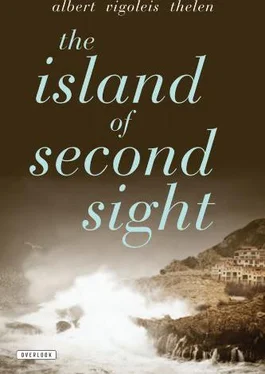I’ve never forgotten that gesture with the ring. Needless to say, by making it, the bishop had won the heart and the trust of an infidel, although he had not won a disciple.
Uniforms and vestments are as dangerous as the war paint on primitive tribesmen. One must be very strong to resist them. Have I been any more successful at this than the missionary who, at the sight of a gang of painted Africans, was overcome with doubt concerning his sacred assignment? Like this man, I soon regained my confidence. Neither of us got eaten up, but we both had succumbed in our own fashion. Full-dress uniform is part of everyday business, even pious business. The Protestant Church is losing its hold on the faithful. I can’t help thinking that if the big-time non-Catholic professors and spokesmen of God’s Word were to put on a little warpaint, if they would don some colorful garb, swing a censer now and then, and talk in a foreign language, their cause would soon reap its proper benefits. They wouldn’t have to carry things so far as to fear being mistaken for dolled-up matrons, as once happened to the Patriarch of Lisbon on the island of Madeira. But a little more color wouldn’t do any harm. What I mean is that it wouldn’t harm their church, because for a long time none of this has had anything to do with God. God is under church arrest, and to the Protestant theologians He has no greater significance than what Nietzsche said books meant to most people: mere literature. And that is as it should be. In the Catholic Church, on the other hand, the same primeval myth is still as alive as the one that prompted the first African to put a ring in his nose. In our own day and age, as we witness the beginnings of an “a-perspective” era, such things can still produce daily miracles. But my friend Don Juan Gebser, the inventor of the era I am speaking about, knows much more about these things than Vigoleis.
So now I have introduced Pedro Sureda to my reader, establishing connections that stretch across the centuries. Heads had to roll, veils had to get lifted, a king’s name had to be conjured up to facilitate the description of a face, an admiral had to be resurrected from the dead and asked to jangle his decorations, and a heretic had to grovel in the dust before an elaborately caparisoned Servant of God. If I had depicted these things strictly according to nature, we would now be further on — that is to say, I would have used fewer words. But I deliberately dispense with such methods, for I lack command of the writing art. It is difficult to paint the portrait of a person in words in such a way that, if an artist were to illustrate the work, the original character would remain genuine. I once amused myself by comparing the illustrations in the earliest editions of Don Quixote , created before the visual appearance of the Knight of the Mournful Countenance as we know it had developed. Even today, it costs me some effort to imagine the features of my Don Quixote while only reading the text. The later goateed depictions of Cervantes’ protagonist repeatedly get in my way. It’s the same thing with Christ. It’s well-nigh impossible to extricate the genuine article from behind the fossilized Beautiful Man with the Jesus Beard.
As you can see, Vigoleis has no lack of connections on the island. Battle commanders on land and sea have handed him their letters of credential; he is recognized and registered in the best whorehouses in the city; a Catholic bishop’s official letter has recommended this young man’s scholarly ambitions to a bosom friend of Pedro’s Papá, the Archepiscopal Bishop of Mallorca, and the latter has applied his official seal and signed it in his fine, somewhat trembling hand: Joseph, Archiepiscopus, Episcopus Maioricensis . And by an odd coincidence, it turns out that the exhibitionistic young ladies on our patio are related to Pedro.
“You know these señoritas ?”
“On this island everybody knows everybody, although sometimes it’s best to pretend that you don’t. What’s more, we are all related. But between me and the Aguados there’s a double remove.”
And yet it remains a lamentable fact that Vigoleis has been unable to transform all these high-sounding, anointed, palace- and bordello-born connections into cold cash. Not from connections that point to Heaven, not from connections that point to Hell. Even the connections that point nowhere at all haven’t yielded up a single peseta. If you want to find ore, you have to dig shafts in the earth. Vigoleis’ shafts are leading nowhere, just as always.
“Don’t you have any furniture at all?” asked Pedro, who as a pupil of Beatrice’s had arrived for his maiden lesson, and finally to get a look at the man who couldn’t afford the chair that his nature dictated he should be squatting on.
Beatrice had told him about our fateful odyssey. If two people sit opposite each other three times a week for an hour at a time, teaching and getting taught, then certain things will emerge in conversation that can allow an alert learner to reconstruct and ponder pretty nearly the whole saga: the whorish comedy with Pilar, the feral Julietta, the ingenious Zwingli, the “Clock Tower,” the army of monkeys and the poison chest, the twofold refusal of a wardrobe. And the pupil, with his artist’s eyes, will of course gaze at Vigoleis and, if he has a promising visage, will take up his pencil and sketch the schlemiel with a few deft strokes.
Our first conversations took place in a mishmash of Spanish, English, and French. The formal and familiar forms of address were glossed over, or got so mixed up that we chose to use the more intimate pronoun henceforth. The British are so lucky. From cradle to grave they use “you,” and the hapless translators into “du” languages are forced to intuit the moment when things get cozier between the interlocutors.
I don’t know which is worse: not to have a shadow, or not to have a face. Nobody can steal my shadow. I cast it ahead of me as I move along, I cast it behind me, and most often it swallows me up. It is always there. But my face? On a certain occasion the ownership of it was challenged. By Pedro, of course, who walked around with the face of his deposed King. The artist in him gave rise to the confusion.
Unlike Madame Perronet and her lady friend in Amsterdam, Pedro didn’t dress me up in a Dutch naval officer’s uniform and picture me as I set my deceitful course through the Straits of Macassar. Instead, the artist Pedro, the son of a king, detected noble blood in my veins, despite the fact that my nose is not at all aristocratic. So he focused on my chin — poor Vigoleis, will there never be an end to this? Who besides Beatrice had ever reached out for my chin? And he said,
“Your nose is not of the worthy type (castizo) . But your chin, and your marvelously curved lips! Welcome to our island, you Bamberg Knight of ancient German lineage!”
I was a marked man. Pedro held the stirrup for me, I leapt into the saddle and sat there, a hero rattling my saber, gazing off to distant horizons. Vigoleis Imperator. Vigoleis Magnus Dux. Vigoleis Dominus et Rex. But Vigoleis still didn’t own a chair, not to mention a loyal vassal who could assist him in toppling Pilar from the pillar of her innocence and snatching a wardrobe and bedclothes from her apartment.
“So you don’t have any furniture? Not even a couple of chairs? Hold it there, Vigo, just a second, don’t move, your head is just right…”
Pedro went on sketching. Presumably he had now espied a facet of my Bamberg countenance that revealed a soupçon of Hohenstaufen arrogance, rather than some bastardized distortion that would ruin this whole artistic enterprise.
“We don’t have many chairs in our house, either. One chair for the three of us. That’s why we’re all so much on the move. But in Valldemosa, in our feudo , Papá has hundreds of chairs. Valldemosa is a village up in the mountains, and that’s where our castle is, the one we had to vacate — debts, lousy management, women. Papá, you have to know, is hornier than a billygoat in springtime when the leaves start sprouting. I can’t wait to introduce you.”
Читать дальше












